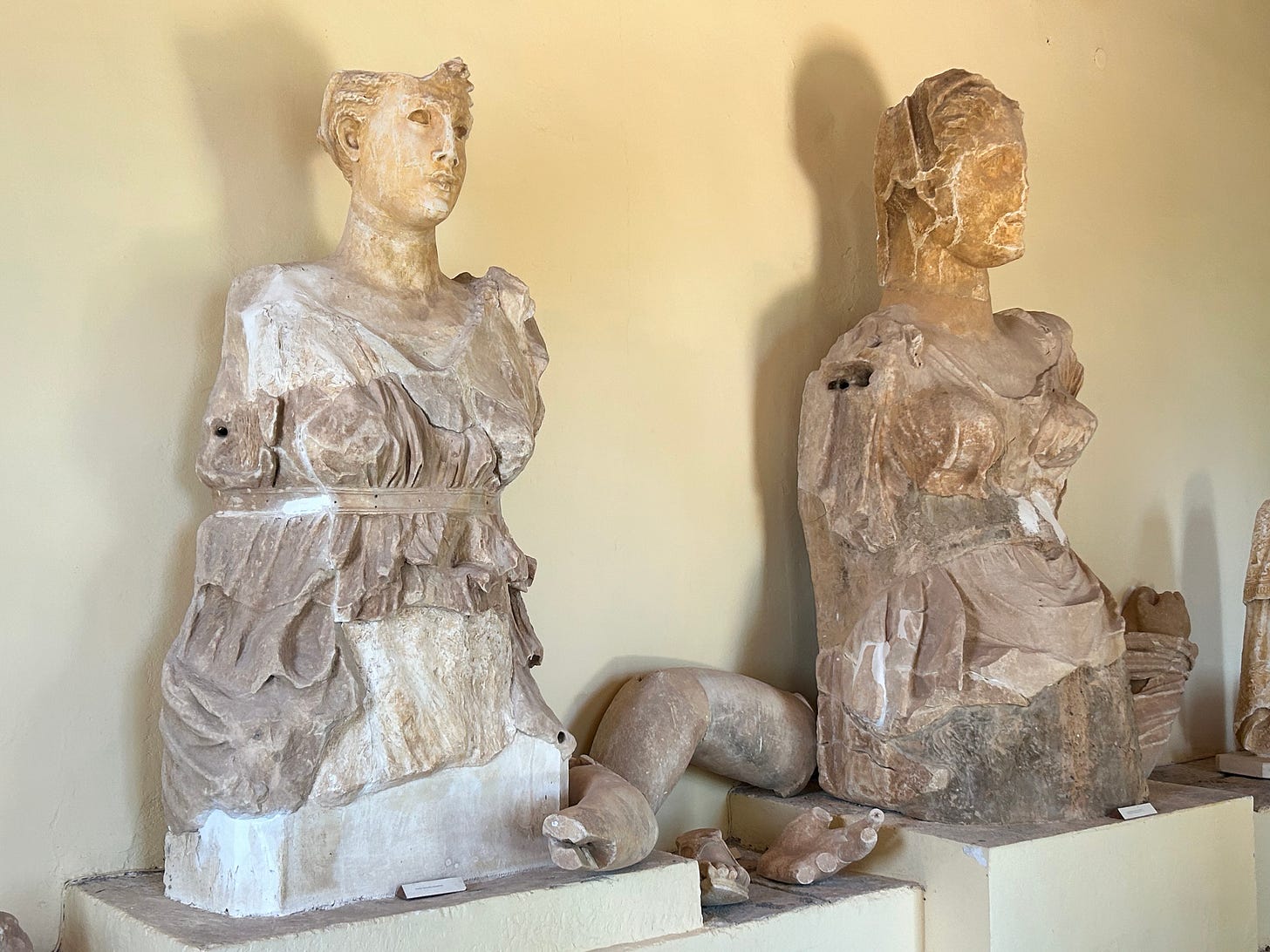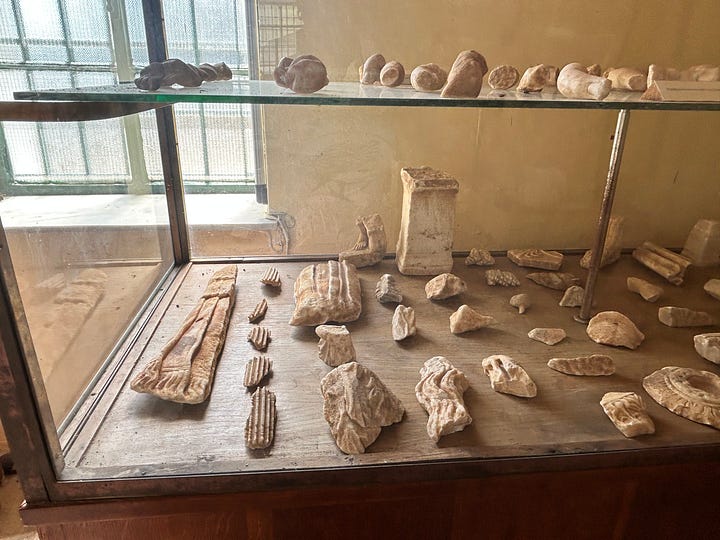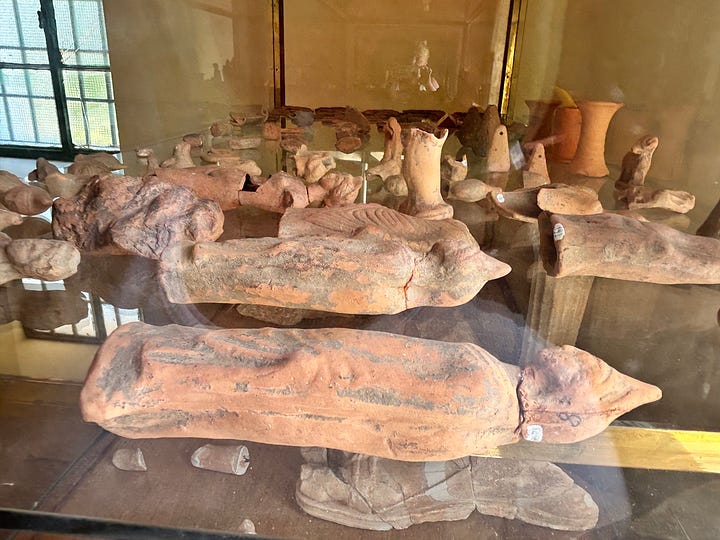Sandra and I hit the road at dawn, buzzing with that strange blend of hope and dread you get when planning to visit a site that's ‘temporarily closed.’ “Don’t expect much,” Sandra sighed as we wound our way up the mountain. She nudged my elbow and said, “We might just see it from the fence.” Ever since she sent her polite, hopeful email to the Museum of Tripoli, weeks ago, there’d been no reply. Yet there we were, tackling the serpentine roads of another mountain, excited to look at abandoned ‘rocks and ruins’, steeling ourselves for disappointment.
But then… a miracle. A small car sat just beyond the gate. I slowed the car almost in disbelief as I saw the gate itself had already been unlocked and stood open, revealing the gravel path leading down toward the sanctuary and the tiny on-site museum nestled at the top. I turned to Sandra, barely able to whisper, “The goddess has opened it for us.” Sandra tried to suppress her laugh, but I was already practically jumping out of the car before I even managed to put it in park. I could feel my whole body vibrating with excitement. Perhaps someone at the Museum of Tripoli had finally seen Sandra’s email, or perhaps it was pure grace, either way, the door had been opened for us, and that was all that mattered.
As we pulled in, my excitement must have been radiating. At first, the guard seemed a little hesitant, almost like he wasn’t quite sure what to make of us being there, but after a few moments he warmed up, and eventually even smiled as he unlocked the gate leading to the opposite side of the temple, where we walked past what remains of the large fountain and water basin that once marked the sacred approach to the sanctuary. From there, we crossed the road back to the temple site and followed the wooden-planked steps cut into the hillside, descending slowly into the valley where the colossal statues of Artemis, Demeter, Despoina, and the Titan Anytos once stood in their full majesty. We wandered carefully around the stones, quietly trying to reconstruct the ancient layout in our minds. I searched for the altar of Artemis, but there were no labels, no markers, no signs, it remains unmarked even today. I finally sat on the side steps just outside the foundation of the temple itself, needing to pause and take in the immensity of this moment: the absolute privilege of standing here, spending the day on-site, surrounded by ruins I had studied and dreamed of for so many years as a graduate student.
After we had thoroughly documented every stone, every block, and every weathered gap in the earth, we slowly made our way back up the hill toward the small museum. I was out of breath by the time we reached the top, not just from the climb but from the sheer overwhelming moment of realizing where I was standing. Inside, the guard gently opened the door to the one-room museum and there they stood: the two remaining colossal torsos of Artemis and Demeter. I had seen the heads of these statues in the National Archaeological Museum in Athens before, but I had never truly allowed myself to believe that I would one day stand here, in Lykosoura itself, before the fragments of their bodies. I must have taken hundreds of photographs, so many that I think the poor guard started to wonder if I was completely mad. He smiled kindly as he showed us the reconstruction drawing of what the entire cult group would have originally looked like in its towering, monumental form.
And then, before we left, he handed us the guest book. With shaky hands and the deepest kind of gratitude, I signed my name into that simple book, knowing full well that I was recording not just my visit, but my honouring of the goddess who had opened this door for us. In that quiet act, beneath the weight of marble torsos and ancient oaks, I felt her presence deeply. Artemis had led us here. She wanted us to see this place.
Artemis at Lykosoura: The Huntress Who Leads
Though the sanctuary is named for Despoina, Artemis plays a far more central role here than many people realize. Pausanias, writing in the 2nd century CE, describes how within the cult group Artemis stood to the left of Demeter, holding a torch and two snakes, dressed in a deer-skin, with a hunting dog at her feet (Paus. 8.37.3–5). This is not the Olympian Artemis most people picture. This is Artemis as both Kynegetis ("Huntress") and Hegemone ("Leader").

The epithet Kynegetis appears in inscriptions across the Greek world and emphasizes her role as goddess of the hunt, mistress of animals, and protector of wild spaces (EBGR 2014). At Lykosoura, however, Artemis is not simply the goddess of the chase. She participates directly in the sanctuary’s mystery rites. The deer-skin she wears speaks of the hunt, yes, but also of sacrifice. The dog at her feet evokes the wild companions of Arcadia’s forests, but also her protective role over the sacred precinct. The torch and the snakes she holds point beyond the hunt, toward something deeper: initiation, transition, and chthonic power.
Her second epithet here, Hegemone, shifts the focus entirely. As Hegemone, "She Who Leads," Artemis becomes the guide of initiates, the threshold guardian who leads participants into the mysteries of Despoina (Paus. 8.38.11). Archaeologist Dimopoulou notes that the temple’s architecture, particularly the side doorway that opens toward the theatre-like seating area, may have been designed to facilitate staged ritual experiences, where deities like Artemis were visually presented as guides into sacred knowledge (Dimopoulou 182–186). As Brill’s study on Greek mystery rites notes, torches are often symbolic markers of entry into hidden wisdom (Brill 2014). Artemis’ torch here is not simply light, it is a ritual instrument of passage.
The Rituals of Sacrifice
The sacrifices performed at Lykosoura were equally distinct, and strikingly different from what we typically find in other Greek cults. In most sanctuaries across the Greek world, sacrificial animals were killed by cutting the throat, following a relatively controlled and uniform ritual structure. But here, Pausanias tells us, the animals offered to Despoina were not slaughtered in this way. Instead, the limbs were cut off, a violent, almost surgical dismemberment that left the animal otherwise intact (Paus. 8.38.8). The separation of limbs rather than a clean death suggests a ritual act that was not simply about killing, but about unmaking, undoing the creature, part by part, in a physical reenactment of cosmic or mythological separation.
This method would have been a powerful visual experience for those present. The act of removing the limbs one by one carries a weight of symbolism: dismemberment as purification, as sacrifice, as the offering of parts rather than the destruction of the whole. Stavridi and Göeger describe this practice as “a ritual deconstruction of prey and self, a visceral dialogue with death and renewal” (Stavridi & Göeger 2024, 58). In this space of offering, the animal’s body becomes both the object and the vehicle of transformation, a pattern deeply connected to mystery cult practices across the ancient world, where breaking apart precedes reassembly in new form.
And it is Artemis, in her aspect as Kynegetis, who stands at the centre of this ritual moment. As goddess of the hunt, she presides not only over the chase but over the moment of death and transition. She oversees that precise instant when the boundary between wild animal and sacrificial offering collapses. The snakes she holds, chthonic emblems of death, rebirth, and endless cycling, mirror the same process unfolding at the altar: life unravels into death, death folds back toward regeneration. She is not merely present; she sanctifies the very act of severing. She turns what might otherwise be violent into something sacred, something necessary for the mysteries unfolding at Despoina’s sanctuary.
The Chthonic Dance and Arcadian Memory
Alaya Palamidis (2018) emphasizes that Lykosoura represents an Arcadian religious continuity that stretches back far earlier than its Hellenistic monumentalization. Even though Megalopolis was founded through political synoecism in the 4th century BCE, Lykosoura retained its independent sacred significance. This sanctuary was not built as an entirely new invention, but as a continuation of deeply rooted local traditions that had long defined Arcadian religious life. The sanctuary’s iconography, especially the carved Tritonesses, Korybantes, and Kouretes on Despoina’s veil, preserve memories of much older ritual forms (Palamidis 182–217).
The presence of these figures, part-human, part-animal, locked in ecstatic postures of movement and ritual sound, evokes an older stratum of Mediterranean cult practice, one far more archaic and visceral than the orderly civic rituals that dominated Classical Athens. These were the kinds of rites where masks concealed identity, where music and rhythm induced trance, where boundaries between human and divine became permeable. The Kouretes and Korybantes, known for their armored dances and wild movements, may have served as protectors of the mysteries or initiators of ecstatic states, their masked performances reenacting the cosmic drama of death and rebirth central to chthonic worship.




And here, within this charged space, Artemis does not stand apart as a distant Olympian virgin. She is embedded deeply within the mystery itself. As both Hegemone and Kynegetis, she participates in this ritual lineage, a goddess not only of thresholds and the wild but of transformation and renewal. The same ritual energy that pulsed through the masked dancers of the Korybantes resonates through her presence, connecting her to the deeper, older world that Lykosoura preserved even as the rest of the Greek world moved into its polished Classical phase. Artemis, here, belongs as much to the ancient drumbeats of Arcadia as to the formal marble cult statues standing above.
Why Build It Here?
But even as I stood there that day, quietly circling the foundation stones and walking between the fractured remains of the colossal torsos, the larger question lingered heavily in my mind: why build these enormous statues here, high up on this remote Arcadian slope? Lykosoura is not Eleusis or Delphi. It was never a pan-Hellenic centre drawing thousands of pilgrims; nor was it tied to the major political machinations of the Greek world. And yet, in this hidden corner of Arcadia, they erected towering figures of Demeter, Despoina, Artemis, and Anytos, each carved with immense effort, expense, and artistic mastery.
Part of the answer lies in Arcadia itself, a land that somehow preserved older cult traditions that elsewhere had long since faded or been absorbed into Olympian order. As Palamidis argues, Lykosoura was monumentalized during the Hellenistic period as an intentional statement of regional identity and religious continuity (Palamidis 2018). These statues were not built for public display or civic pageantry; they were never intended for political theatre or mass tourism. They were carved for those few who came seeking, for the initiated who ascended into the wilderness, who crossed into this chthonic realm of mountains and mist, who entered Despoina’s sanctuary and stood before these towering presences to encounter mystery directly.
The scale of the statues amplified that mystery. The sheer size of the figures would have made the mortal visitor feel small, humbled, and acutely aware of their place within a much older, more sacred world. Standing beneath Artemis, her deer-skin draped across colossal shoulders, torch and serpents once gleaming in her carved hands, was not simply a visual experience, but a ritual confrontation with the very forces of wildness, protection, death, and transformation. These stones still carry that charge, even in their broken state. And on the morning Sandra and I stood there, alone but for the silent stones, the thin mountain air, and the rustling of leaves, it was hard not to feel as though we had been personally invited into that same ancient encounter.
If you’re inspired by this work and want to support what we’re building, whether it’s mapping forgotten temples across Greece and Turkey, researching ancient rites, or making goddess-centred education more accessible, please consider supporting this blog, sharing it, or becoming a patron.
You can also purchase my book, She Who Hunts: Artemis, the Goddess Who Changed the World, a heartfelt and scholarly introduction to the Greek Artemis. It’s a great place to begin if you're curious about her history, her many faces, and why she still matters today.
Every offering helps fund fieldwork, content creation, and the long work of restoring her memory, one step at a time.
With strength,
Carla
www.artemisresearchcentre.com
Works Cited
Brill. IV. Greek Mysteries in Roman Times (Cambridge, 2014).
Dimopoulou, Sotiria. 2022. Die Kultbildgruppe im Heiligtum der Despoina zu Lykosura. Baden-Baden: Tectum Verlag. (See Chapter 5, pp. 181–186.)
Dimopoulou, Sotiria. 2024. “Mysteries and Interactivity: The Relationship between Demeter Kore at Eleusis and Demeter Despoina at Lykosura.” Göttinger Forum für Altertumswissenschaft 27: 43–76.
EBGR 2014. Epigraphic Bulletin for Greek Religion, inscriptions referencing Artemis Kynegetis.
Palamidis, Alaya. 2018. “The Sanctuary of Despoina at Lykosoura: A Megalopolitan Creation?” in Arkadien im Altertum, ed. Klaus Tausend, 182–217. Graz: Unipress Verlag.
Pausanias. Description of Greece, 8.37.3–5, 8.38.8, 8.38.11.








We cannot judge the past by modern mores. There were no supermarkets to purchase neatly packaged fillets; life was short, harsh, and brutal, and humans not exempt from natural disasters. Unpleasant as it may seem to modern sensibilities, we need to step into that world to truly understand the whys and wherefores. The conceptual frameworks of the deities and the practices associated with them are ultimately human and derive from the realities of life in that context. There are regions of Greece in which ritual animal sacrifice persists - to the new religion - but the practices remain the same. Yes, the animal is slaughtered fairly humanely first, but it reflects the power of the symbolism as it has persisted through time, and the conceptual framework that makes it acceptable.
BRAVA!! I so envy you both sharing this incredible experience. You've helped me conjure the old feeling of standing in Her sacred sites with that thin veil of remembering....